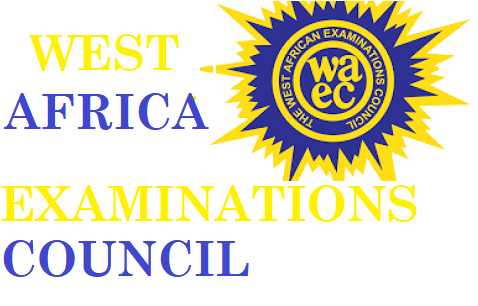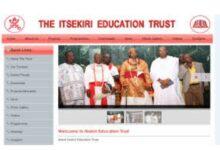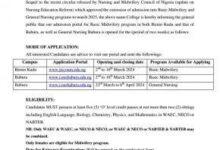
WAEC Syllabus for Woodwork
WAEC Syllabus for Woodwork. WAEC Syllabus for Woodwork is available for all candidates who want to participate in the examination. The West African examination council (WAEC) has officially introduced a syllabus that will guide all the WAEC candidates who wish to write the WAEC examination this year. For a very successful WAEC Woodwork examination for this year, you need to check out the available areas of concentration. It has been divided into sections with chapters, followed by the topics to be covered in preparation for the exams. In the WAEC Syllabus for Woodwork, you will also see the format of how the WAEC Woodwork questions will be presented.
There are 3 sections to answer questions from. Paper 1 is Objective and paper 2 contains essay questions and paper 3 is the practical section. Where paper one (1) carries 40 minutes for 40 marks; paper two (2) carries 2 hours, 20 minutes and paper 3 is 3 hour for 100 marks.
👉 Relocate to Canada Today!
Live, Study and Work in Canada. No Payment is Required! Hurry Now click here to Apply >> Immigrate to Canada
This WAEC syllabus is for both the O’level WAEC and General Certificate Examination (GCE) candidates. Final year students in the senior secondary school level and external candidates are eligible to make use of this syllabus and prepare ahead of the examination. WAEC Syllabus for Woodwork
See the full detailed information concerning the WAEC Woodwork Syllabus below.
SCHEME OF EXAMINATION
There will be three papers, Papers 1, 2 and 3 all of which must be taken. Papers 1 and 2 will
be a composite paper to be taken at one sitting.
PAPER 1: Will consist of forty multiple-choice objective questions all of which must be
answered within 40 minutes for 40 marks.
PAPER 2: Will consist of theory and design paper of two sections, Sections A and B, to be
👉 Relocate to Canada Today!
Live, Study and Work in Canada. No Payment is Required! Hurry Now click here to Apply >> Immigrate to Canadataken within 2 hours, 20 minutes.
Section A: will be short structured questions put into three parts, Part I, II and
III as follows:
- Part I will be for candidates in Ghana only.
- Part II will be for candidates in Nigeria, Sierra Leone and The Gambia.
- Part III will be for all candidates. It will comprise of two questions out of which all candidates will be required to answer one.
Section B: Will comprise design and drawing questions, all of which must be
answered within 1 hour 40 minutes for 40 marks.
PAPER 3: Will be a practical test lasting 3 hours. Candidates will be required to make
a test piece for which the appropriate drawings will be supplied. It will carry
100 marks.
CONTINUOUS ASSESSMENT
A continuous assessment score for the subject shall include marks for assessment of finished projects by the candidates. The products must be left undestroyed for at least six months after the release of results. It is recommended that at least three specific projects be produced during the course by each candidate.
DETAILED SYLLABUS
THEORY AND DESIGN
| S/NO. | TOPIC | CONTENT | NOTES |
| 1. | General Workshop Safety | (a) Personal safety precautions. (b) General Workshop safety regulations. (c) Safety devices and appliances. (d) Hand tool safety.
(e) Machine safety: (i) General machine shop safety; (ii) Safety precautions in the use of portable power tools and machines; (iii) Safety in machines operations; (iv) Prevention of mechanical faults. (f) First aid. |
Types and uses
Safety precautions in carrying, storing, and handling hand tools.
Materials and administration. |
| 2. | Hand tools | (a) Types
(b) Classification: geometrical, holding and supporting, impelling and percussion, cutting, boring, abrading and scraping tools. |
To include identification, description and sketching. |
| 3. | Special Purpose Hand tools. | Types and uses:
|
To include identification, description and sketching. |
| 4. | Portable Power tools. | (a) Types: Power drill, jig saw, spray gun, screw driver, sanders, router, power circular saw, etc.
(b) Uses. |
To include identification, description, care and safe use. |
| 5. | Woodworking machines. | (a) Types: Circular saw,
crosscut saw, thicknesser, surface planer, mortiser, lathe, grinding wheel, drilling machine, etc.
(b) Uses.
(c) Safety Precautions. |
To include identification, description, care and safe use.
To include the use of guards, fences, push sticks, push blocks, gauges etc. |
| 6. | Maintenance | (a) Types: corrective, routine, predictive and preventive.
(b) Reasons for maintenance
(c) Maintenance of hand tools.
(d) Maintenance of machines. |
To include maintenance activities, materials and tools.
To include oiling, sharpening, repairing, storing etc.
To include cleaning, oiling, servicing, replacing parts etc. |
| 7. | West African Timbers in common use. | (a) Timber growth and
structure. (b) Common West African Timbers e.g. Iroko (Odum), abura, mahogany, obeche (Wawa), African walnut, afara, ebony, danta, emery, shedua, mansonia, cedar, afromosia (kokrodua), avodire, kusia.
(c) Characteristics.
|
Structure to include classification, e.g. soft/hardwoods. Parts and their functions
Surface, working and mechanical qualities, similarities and differences. |
| (d) Uses | Specific uses. | ||
| 8. | Timber Conversion | (a) Explanation.
(b) Conversion methods: (i) plain/through and through/live sawing; (ii)Tangential/back/flat/ rake sawing (iii)Quarter/radial/rift sawing;
(c) Common market sizes: log, plank, scantling, board, batten, strip/lath, squares. |
Characteristics, advantages and disadvantages of each method.
Including, identification description and uses. |
| 9. | Timber seasoning | (a) Explanation.
(b) Reasons for seasoning
(c) Methods of seasoning: Natural/open air , artificial/kiln, water and chemical seasoning.
(d) Determination of moisture content: (i) moisture meter method; (ii) oven-dry method. |
Advantages and disadvantages of each method.
Advantages and disadvantages of each method. Calculation of percentage moisture content. |
| 10. | Timber defects | (a) Explanation of timber defect.
(b) Types of defects (i) natural growth defects; (ii) felling defects; (iii) conversion defects; (iv) seasoning defects; (v) defects caused by Organisms. |
Causes, prevention, remedies, description and sketching. |
| 11. | Timber preservation | (a) Reasons for preserving
timber. (b) Common timber preservatives (c) Properties of a good timber preservative (d) Methods of applying timber preservatives: brushing, dipping, spraying etc. |
To include specific uses.
Advantages and disadvantages of each method. |
| 12. | Manufactured boards | (i) types;
(ii) structure; (iii) characteristics (iv) uses. |
To include description and uses.
Advantages and disadvantages of each type. |
| 13. | Timber Preparation | (a) Selection of tools and
machines (b) Operational sequence: (i) hand preparation; (ii) machine preparation. |
To include practical preparation of stock. |
| 14. | Woodwork joints | Classification:
(i) widening joints: simple butt, dowel, tongued and grooved, loose tongue, rebated butt etc. (ii) angle joints: mortise and tenon, dowelled butt, dovetails, housing, halving etc. (iii) framing joints: mortise and tenon, bridle, plain mitre, dowelled butt, halving etc. |
To include identification, description, sketching, construction, specific use etc. |
| 15. | Wood finishes and finishing. | Wood finishes:
(i) types: fillers, stains, paints, varnishes, lacquers, polishes etc. (ii) application of finishes: – surface preparation; – tools; – methods: brushing, spraying, dipping, etc. |
To include: (i) properties, characteristics and uses of each. To include: (i) stages and tools for each method. (ii) Safety precautions.
|
| 16. | Wood abrasives | (a) Meaning
(b) Grades: coarse, medium and fine.
(c) Selection and uses. |
Identification, selection and uses.
To include specific application of each grade. |
| 17. | Wood adhesives | Types:
(a) protein: animal, casein (b) synthetic resins: urea, phenol and melamine formaldehydes, epoxyl resins, polyvinyl acetate (PVA). (c) contact/rubber based |
To include characteristics, uses, preparation and application and safety precaution during application. |
| 18. | Wood fittings and fasteners | (a) Fittings: e.g. hinges,
locks, handles, bolts, catches, etc.
(b) Fasteners: Nails, screws, bolts and nuts, corrugated fasteners etc.
|
To include identification, description, sketching, uses, application, fixing etc.
To include identification, description, sketching, uses, application, fixing etc. |
| 19. | Non-wood materials | Types: Glass, plastics, rubber,
ceramics, metal, leather, etc. |
To include identification, description, characteristics, uses and other types of each. |
| 20. | Veneers and Veneering | (a) Veneers: Types
Production. (b) Veneering: (i) Methods: hammer, press. (ii) Tools: veneer hammer, pressing iron, cramps, caul, etc. |
To include identification, description and uses.
To include the processes for each method.
To include identification, description, sketching and uses. |
| 21. | Wood shaping and bending. | (a) Shaping: Rounding,
moulding, bevelling, chamfering, tapering, carving, etc.
(b) Bending: Solid, laminated
|
To include identification, description, sketching, processes, techniques, tools and machines, properties of wood suitable for each. |
| 22. | Design and Drawing | (a) Concept of design;
(b) Design fundamentals and processes; (c) Free hand sketching; (e) Working drawings; (f) Cutting list and bill of materials; (g) Basic draftsmanship skills.
|
Working drawings in the First and Third Angle orthographic projections. Indication of cutting correct sectional representation of the materials are assential. |
| 23. | Project Design and Construction. | (a) Identification and
analysis of given design problems. (b) Designing to solve the problems. (c) Estimating the cost of the design. (d) Constructing to meet the design specification.
|
Design problems should arise from customer needs, market survey, situation analysis, etc.
To include evaluating the product to meet design purpose and specification. |
| 24. | Upholstery | (a) Upholstery work.
(b) Hand tools and machines: needles, pair of scissors, hammer, webbing stretcher, sewing machine, buttoning machine.
(c) Materials e.g. for framing, stuffing/padding, covering, decorating.
(d) Processes and techniques: framing, padding, covering, finishing, decoration, etc.
|
To include description, types and parts.
Identification, description, sketching, care and uses.
To be applied in constructing upholstery project. |
| 25. | Wood turning | (a) The wood lathe: Parts and
accessories.
(b) Turning tools: chisels, gouges, calipers, etc.
(c) Turning operations: face plate turning, turning between centres and boring.
(d) Suitable wood for turning: abura, ebony, mahogany, etc. (e) Projects: vase, bowl, candle holder, etc. |
Identification, description, sketching, care, uses and safe use.
To include identification and specific use.
To include description and actual turning. |
| 26. | Wood carving and sculpture | (a) Carving: incise and relief.
(b) Sculpture: Production of simple ornaments.
(c) Tools e.g. chisels, gouges, knives, files, etc. |
To include description, identification, application and processes.
To include identification, sketching and uses. |
| 27. | Surface Decoration | Types: inlaying, veneering,
marquetry, lamination, laminated plastics, mouldings, etc. |
Identification, description, processes, techniques and application. |
| 28. | Mass Production | (a) Concept and principles.
(b) Processes: Market survey, design, production, quality assurance, sales/marketing, management, procurement, cost estimation, tooling up for production. |
To include mass production terms, e.g. templates, fixtures, trial run, departments, section, prototype, quality control, etc.
Basic knowledge of the concepts required. |
| FOR CANDIDATES IN NIGERIA/ SIERRA LEONE/THE GAMBIA ONLY | |||
| 29. | Entrepreneurship in Woodworking. | (a) Types of business
organisation e.g. sole proprietorship, partnership, cooperatives etc.
(b) Business opportunities in Woodworking: e.g. merchandizing, spray painting, upholstery work, wood turning.
(c) Business plans: format and content.
(d) Sources of fund e.g. gifts, personal savings, loans, inheritance, cooperatives etc.
|
To include characteristic advantages and disadvantages.
To include sample plans.
To include benefits and the risks. |
SUGGESTED READING LIST
- Woodwork in Theory and Practice – John A. Walton, Australian Publishing Company.
- Woodwork Design and Practice – David M. Shaw – Hodder and Stoughton
- Woodwork by G. N Green
- Basic Principles of Woodwork Design and Drawing – Emmanuel A. Nnenji Aranke woods
- Practical Upholstery – C. Howes F.A. M.U
Evans Brothers Limited, London.
- General Certificate Woodwork by H. E. King
- Fundamentals of Woodworking by Nurudeen et all
- Woodwork by G. W. Brazier and H. A. Harris
- Advance Woodworking and Furniture Making by J. Fierre and G. Hutchings
- Woodwork for Senior Secondary School by CESAC
- Woodwork for Senior Secondary School by J. N. K. Sackey, G. Manu and R. Y. Baafi
- Woodwork Made Simple by Tom Pettit
- Woodwork Technology by John Strefford Guy McMurdo
- Woodwork by E. J. Wunter
- Woodwork Technology by J. K. N. Sackey
- Woodworker’s Pocket Book by Charles H. Hayford
- Collins complete woodworker’s Manual by Jackson Albert and Day David
Check and Confirm: How much is Dollar to Naira Pounds to Naira Rate Today






